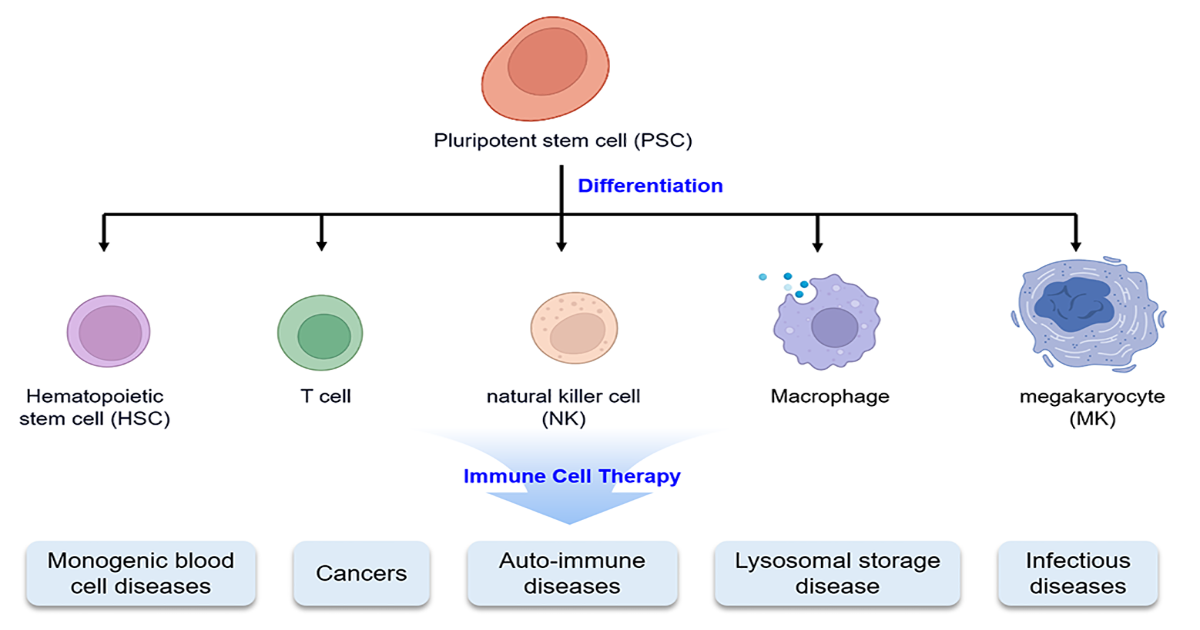- 5.2Impact Factor
- 10.5CiteScore
- 16 daysTime to First Decision
Immune Cells from Pluripotent Stem Cells
This special issue belongs to the section “Stem Cells“.
Special Issue Information
Dear Colleagues,
Immune cells exhibit diverse functions such as maintaining homeostasis, defense against pathogens, and regulating immune responses. Immune cells include T cells, B cells, macrophages, natural killer (NK) cells, dendritic cells, and even platelets. These are differentiated from hematopoietic stem cells.
Recently, with the commercialization of CAR-T cells for cancer treatment, interest in immune cell therapy is increasing. However, immune cells isolated from the human body have several limitations, including availability, variability between donors, and challenges in large-scale manufacturing.
Pluripotent stem cells (PSCs) offer a promising alternative due to their unlimited self-renewal and ability to differentiation into various cell types under appropriate conditions. PSCs can also be genetically engineered and differentiated into different immune cell types, potentially overcoming limitations of primary immune cells.
This Special Issue will examine the methods of differentiation and efficacy in vitro and in vivo of immune cells from PSCs.
Prof. Dr. Eunju Kang
Guest Editor
Manuscript Submission Information
Manuscripts should be submitted online at www.mdpi.com by registering and logging in to this website. Once you are registered, click here to go to the submission form. Manuscripts can be submitted until the deadline. All submissions that pass pre-check are peer-reviewed. Accepted papers will be published continuously in the journal (as soon as accepted) and will be listed together on the special issue website. Research articles, review articles as well as short communications are invited. For planned papers, a title and short abstract (about 250 words) can be sent to the Editorial Office for assessment.
Submitted manuscripts should not have been published previously, nor be under consideration for publication elsewhere (except conference proceedings papers). All manuscripts are thoroughly refereed through a single-blind peer-review process. A guide for authors and other relevant information for submission of manuscripts is available on the Instructions for Authors page. Cells is an international peer-reviewed open access semimonthly journal published by MDPI.
Please visit the Instructions for Authors page before submitting a manuscript. The Article Processing Charge (APC) for publication in this open access journal is 2700 CHF (Swiss Francs). Submitted papers should be well formatted and use good English. Authors may use MDPI's English editing service prior to publication or during author revisions.
Keywords
- pluripotent stem cells
- T cells
- B cells
- macrophages
- natural killer (NK) cells
- dendritic cells
- megakaryocytes
- platelets

Benefits of Publishing in a Special Issue
- Ease of navigation: Grouping papers by topic helps scholars navigate broad scope journals more efficiently.
- Greater discoverability: Special Issues support the reach and impact of scientific research. Articles in Special Issues are more discoverable and cited more frequently.
- Expansion of research network: Special Issues facilitate connections among authors, fostering scientific collaborations.
- External promotion: Articles in Special Issues are often promoted through the journal's social media, increasing their visibility.
- e-Book format: Special Issues with more than 10 articles can be published as dedicated e-books, ensuring wide and rapid dissemination.

